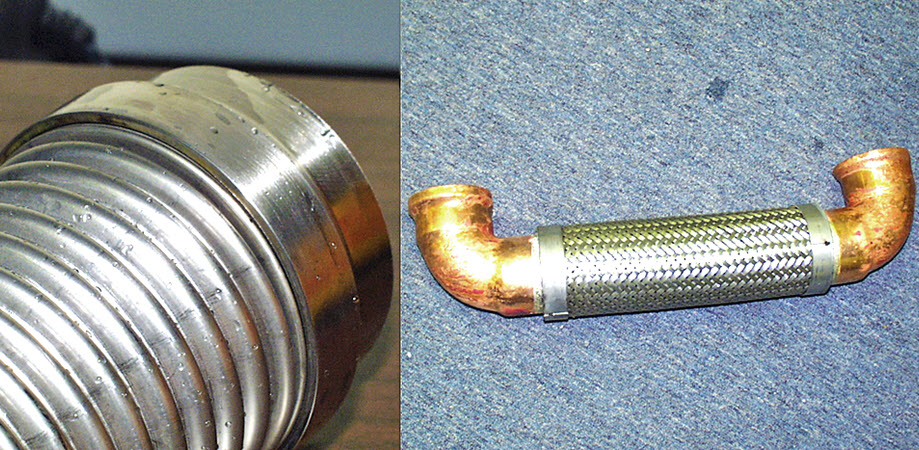Curing Material on an Aluminum Mandrel
Objective Heat a customer supplied aluminum cylinder to 80-120°C for a material curing application. More application notes
Processes
Processes: More
Processes: More

Industries:
Industries: More
Industries: More
Industries: More

Products:
Products: More
Services:
Services: More

Learn:
Learn: More
About:

2 min read
Justyna Bakker
11/22/15 4:24 AM

Flexible tubes and hoses are increasingly an essential subset of a number of tube and pipe installations in the automotive industry. A flexible hose assembly not only provides flexibility in manual handling applications but also compensates for regular or constant movement. These hoses also absorb vibrations and often correct misalignment between rigid connections.
More brazing application notes
Flexible metal hoses in comparison to plastic or rubber hoses can handle a wide variety of chemicals, work at elevated temperatures, are often less susceptible to gas permeation and have the advantage of a wide variety end fittings. Flexible metal hose is typically produced in either strip wound or corrugated type based on its design and application. While the former has higher mechanical strength the latter is able to withstand higher pressure (using a stainless steel wire braid over the hose) and provide maximum leak tightness.
Ambrell EASYHEAT and EKOHEAT product lines are designed and developed to provide customized induction heating solutions for a number of applications in the manufacture of flexible metal hoses.
Induction heating is a method of providing fast, consistent heat for manufacturing applications which involve bonding or changing the properties of metals or other electrically-conductive materials. The process relies on induced electrical currents within the metal material to produce heat. Although the basic principles of induction are well known, modern advances in solid state technology have made induction heating a remarkably simple, cost-effective heating method for applications which involve heating for brazing, annealing, preheat for welding, powder coating etc. The smaller size and responsiveness of newer induction machines have played an increasing role in promoting lean manufacturing.
A basic induction heating setup is shown in Fig 1 below. The induction heating setup consists of a high frequency power supply that takes the input from the AC line mains. This power supply unit converts regular line frequency (50 or 60 Hertz) to a high frequency signal, typically operating between 10 and 400 kHz. This high oscillating signal is then fed to a tank circuit that feeds the water cooled induction heating coil. The high frequency signal generates a high frequency magnetic field inside the induction heating coil. The sample is placed in close proximity to the induction heating coil. This magnetic field creates eddy currents in the sample that produce heat. A temperature measuring instrument like a pyrometer or a thermocouple can be used to measure the temperature of the sample. Its output can be then fed to a controller that can regulate the rate of increase of temperature as well as maintaining a particular sample at temperature for a specific amount of time.

Induction brazing is a common method used to attach these fittings to the flexible metal hose. Brazing is a heating process in which two or more like or unlike materials are joined together by means of another metal alloy with a lower melting point. Braze joints can be made exceptionally strong, sometimes stronger than the two metals being joined. Braze joints are liquid- and gas-tight, can withstand shock and vibration, are unaffected by normal temperature changes, provide good electrical conductivity and can be easily plated using conventional processes.
The end fitting is either made of steel or copper, depending on the location of its final use. This application was all about copper brazing and steel brazing. A specifically designed induction heating coil was developed to deliver uniform heat to the hose and the fitting. An Ambrell EASYHEAT 8310, 10 kW induction heating power supply is used to heat the steel fitting to hose joint to a temperature of 1400F (730C) within 2 minutes. The copper end fitting to steel hose assembly required a 15 kW power supply to complete the same braze joint within 2 minutes.
Ambrell designs the induction heating solutions to your needs. We have over 30 years of experience with a huge variety of induction heating applications. What makes us unique aside from our outstanding quality of equipment, rich application knowledge and responsiveness? The answer is service. We offer free of charge lab analysis at THE LAB at Ambrell where our experts tailor the right solution for you. Thanks to our innovative technology, capability in coil design and materials know-how we put induction heating to work to your advantage.

Objective Heat a customer supplied aluminum cylinder to 80-120°C for a material curing application. More application notes

In today’s manufacturing landscape, efficiency, precision, and sustainability are critical. Induction heating—a process that uses electromagnetic...

When it comes to many manufacturing processes, including this forging application, precision and efficiency are critical. Traditional heating methods...